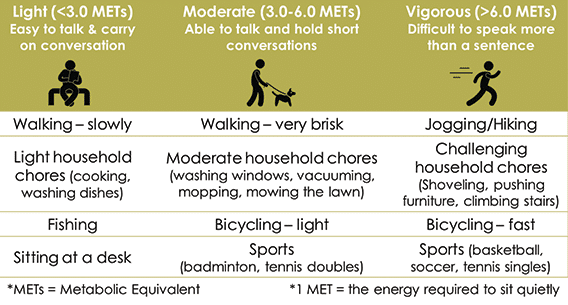This article was contributed by Oncology Dietitian and Clinical Exercise Physiologist, Hannah Manella, MS, RD, LDN, ACSM-CEP, CET (Rush University Cancer Center).

There is no doubt the coronavirus (COVID-19) pandemic and new stay-at-home mandates can make physical activity more challenging.
However, we know that physical activity is a key element in cancer survivorship. Physical activity has been linked to improved treatment outcomes (less fatigue, less treatment delays, shorter, and less frequent hospitalizations, improved physical functioning, and more) and decreased risk for cancer recurrence. Because of these factors, being physically active before, during and after cancer treatment is extremely important. Thankfully, physical activity is not limited to a gym or health club. We can absolutely meet our physical activity recommendations at home, with or without fitness equipment.
General physical activity recommendations for cancer survivors (before, during, and after treatment):
- 150 minutes/week of moderate intensity aerobic activity + 2 days/week strength training
Specific physical activity recommendations during cancer treatment (to decrease fatigue, improve physical functioning, decrease anxiety and depression):
- 30 minutes of moderate intensity aerobic activity 2-3 days/week OR 2 days/week of strength training (2 sets of 12-15 repetitions)
Aerobic Activity
Aerobic activity consists of anything that gets your heart beating faster. Moderate-to-vigorous intensity activities have been linked to the most health benefits, but light intensity activity is also beneficial (especially if feeling unwell from cancer treatment). The table below helps differentiate between light, moderate, and vigorous intensity activity.

Ideally, the goal is to do some type of aerobic activity most days of the week (or 2-3 days/week if going through treatment). Thankfully, the activity does not have to be done all at once. Activity can be broken up into 5-10 minute intervals if your time or energy is limited.
Here are some home-based aerobic activities you can try:
- Walk briskly around the house (or outside if your local government allows).
- Climb the stairs (if balance is an issue, do step-ups on the first 1-2 steps).
- Clean the house, garden, or yard work are great forms of activity.
- Put on your favorite playlist and dance!
- Do free online exercises (the videos below were developed by cancer exercise specialists).
Strength Training
Physical activity guidelines recommend doing strength training activities, at least 2 days per week. These activities often involve weights, elastic bands, or even body weight (i.e. push-ups or body weight squats). The key to strength training is to target major muscle groups. For maximum muscle strengthening, do at least 2 sets of 12-15 repetitions.
Here are some suggestions for targeting your major muscle groups:
- Legs (glutes, quadriceps, hamstrings, calves)
- Squat (or chair sit-to-stand)
- Lunges (or single leg step-ups on stairs)
- Back (upper and lower)
- Rows with dumbbell or resistance band
- Back extensions or “superman”
- Chest
- Push-ups (on floor or against wall/counter)
- Shoulders
- Shoulder press with dumbbell or resistance band (shoulder raise if unable to lift arms above head)
- Arms (biceps and triceps)
- Bicep curl with dumbbell or resistance ban
- Tricep dips (on sturdy chair or step)
- Abdominals
- Planks (on ground or against counter)
- Leg raises (on ground or sitting in a chair)

Be sure to start each workouts with a 5-10 minute warm up. This will increase your blood flow and relax your muscles, and lower your risk of injury.
- Warm up exercises: arm swings, torso twists, marching in place, jumping jacks, and quick feet.
Avoid stopping your workout abruptly. Set aside 5-10 minutes after your workout to slow down, lower your heart rate, and stretch.
- When stretching, be sure to hold the movement for 10-30 seconds.
Key Takeaway
Don’t sit all day! Try to stay physically active while at home.
If you can’t participate in structured exercises, simply find ways to move more at home. Whether it’s cleaning, yard work, or even short walks around the neighborhood, any activity counts!
Click here for tips for eating healthy while social distancing.
Click here for healthy recipe ideas using items from your pantry.
 About the Author
About the Author
Hannah Manella is an Oncology Dietitian and Clinical Exercise Physiologist at Rush University Cancer Center in Chicago. Hannah works to improve lifestyle behaviors of individuals during and after cancer treatment. Specifically, she focuses on providing individuals with the tools to make personalized behavior changes for long-term success.
 About the Author
About the Author